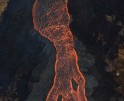Zac Henderson: Art + Science Competition Third Place Winner
Zac Henderson is a semi-nomadic photographic artist currently based in Auburn, Alabama. In his project Dark Matter, he creates otherworldly sculptures by exposing iron filings to the invisible forces generated in a magnetic field. The resulting images reference our efforts to understand the unknown forces that exert their daily influence on us and allow us to contemplate realms outside of our existence and knowledge.
Like all living things, humans are shackled by our senses. Evolution has crafted us into beings adept in methods of survival and gifted us with awareness calibrated for a terrestrial existence. Curiosity and intelligence, two aspects of our nature that have served our species well, perpetuate something evolution did not intend: knowledge of realms outside our existence. Awareness of the universe and its exotic conventions are not necessary for evolution’s prime directive, yet by accident we find ourselves able not just to ask questions about our place, but to also answer them and revel in the climax of understanding. We go beyond ourselves and our humble home in search of truths we are not meant to know. It is this feature of our species which I am most moved by, and what compels me to celebrate the bittersweet wonder of a knowledge not yet realized.
Dark Matter is inspired by a scientific concept of the same name, a form of matter that cannot be directly detected, yet boasts dramatic influence seen at the largest scale in the form of gravity. By exposing iron filings to an invisible magnetic field, the work imagines dark matter particles and their interactions with normal matter through gravity, as seen from a higher dimension, or bulk, in which both are visible. The resulting forms are dynamic, abstract sculptures that celebrate the wonders of both the known and unknowable forms of nature.
Zac Henderson is a semi-nomadic photographic artist currently based in the deep south. His work is deeply influenced by nature, science, and humanity’s effort to reckon with its place in the cosmos. His photographs often explore themes relating to phenomena that exist outside human sensory perception including geological time, imaginings of the quantum realm, emergence, and fundamental natural processes. He is inspired by the paradigm shift gained by reflecting on these and related concepts and seeks to further explore this awareness through his practice.
Henderson received a BFA from the Savannah College of Art and Design and has won several awards for his work. His photographs and writing appear frequently in various publications.
The following is an interview Zac Henderson by Daniel George:
DG: How did the Dark Matter series begin?
ZH: Back in 2017 I was having a lot of trouble determining what my interests in photography were. I loved the medium and was very technical, but I didn’t feel led to photograph a particular subject, which was frustrating. Around this time I was reading quite a lot about cosmology and indulging in that interest. Dark matter was particularly interesting- this thing that permeated the universe and kept galaxies from being flung apart, but didn’t interact with the electromagnetic spectrum and was, for all intents and purposes, invisible to us. I wondered how that interest could be translated into a photograph. After some brainstorming I started experimenting with magnetism in a makeshift studio.
DG: Your images immediately piqued my curiosity due to the odd forms created by the magnetic fields and iron filings. Would you mind sharing a little bit about your process with our readers?
ZH: I start by suspending one or two ceramic magnets with fishing line. Then I expose iron filings to those magnets, observing the shape the filings naturally take along the magnetic field. I then will typically add more magnets to those filings and begin to see potential in how the filings behave when pushed around. I’ll often experiment with different magnet placement and coerce the filings into spindrels, spikes, arches, and other shapes with toothpicks and wooden dowels. I try to push the sculptures as far as I can before gravity takes over and they fall apart. The magnets I use are in a sweet spot because they’re not so strong that they force the filings to compress against the magnet and refuse to work with gravity, but not so weak that only a few filings will attach and prevent the creation of a larger structure.
DG: Your biography states that your work is informed by “nature, science, and humanity’s effort to reckon with its place in the cosmos.” What brought about this wider interest?
ZH: Ever since I was a kid I’ve been interested in science and natural history. Dinosaurs were my number one, but it didn’t end with printed bed sheets, t-shirts, and action figures. I would go to the library and find every book I could that discussed dinosaurs and showed illustrations depicting them, learning as much as I could. Even then I think I enjoyed the bittersweet nature of wondering what they were like, but recognizing no one would ever truly understand them. I still enjoy that bittersweet feeling, but now more so brought on by the parts of the natural world that humans have little to no physical relationship to, yet are gargantuan in their scale and energy and fundamental to how the universe exists, like neutron stars, black holes, dark matter, and dark energy.
DG: In your statement, you write of curiosity and intelligence as evolutionary traits that have led us to a point where we are able to see and understand “truths we are not meant to know.” This certainly brings technology, like photography, to mind because of it’s ability to augment sight. Are there any aspects of this work that have revealed the unknown to you? Care to explain?
ZH: This work really comes down to me playing with magnets and taking pictures, so I can’t say I’ve launched a scientific endeavor that has discovered anything. I will say, however, that I’ve learned much more about magnetism and magnetic fields after spending so much time observing and thinking about them. The three dimensional nature of a magnetic field, for example, is something that, as a non-scientist that wouldn’t typically think about magnetism outside of the every day uses we take for granted, I had never really considered before. Illustrations about magnetic fields are typically 2-D. Even the classic school experiment where you would place a bar magnet under a piece of paper with iron filings on top to observe the magnetic field lines is two-dimensional. The sculptures I’m making, however, very much exist in three dimensions. The filings want to inhabit as much of the magnetic field as gravity will allow in 360º. Adding other magnets in different orientations will complicate the magnetic field and cause the iron to behave very differently. Making this work has definitely made me appreciate and come to understand that three dimensional aspect to magnetism more than before.
DG: This may be a big question, but do you feel this work brings about a greater “awareness of the universe and its exotic conventions?” In what ways?
ZH: I like to think it does. The work isn’t an illustration of dark matter, but it is derived from one person’s fascination with the idea of it. I want the images to start conversations and make people wonder, like I do now and did as a kid, about things fundamental to nature that exist outside our experience. You don’t have to be a scientist to bask in the awe of the universe’s natural forces and be curious about their properties. We get extremely caught up in our own lives by solving problems, worrying about the future, and living day to day dealing with the things that are right in front of us. Of course we do. But I think life is vastly enriched by looking outside of that grind and appreciating the larger situation we find ourselves in. It’s a way to come up for air and appreciate the intense beauty of our situation. I think that a cosmic perspective, as Carl Sagan put it, can be a kind of antidote to the increasingly dire attitude our culture seems to find itself inhabiting, and I wish for the work to be a part of that.
Posts on Lenscratch may not be reproduced without the permission of the Lenscratch staff and the photographer.
Recommended
-
elin o’Hara slavick: Art + Science Competition Honorable MentionDecember 21st, 2024
-
Leslie Gleim: Art + Science Competition Honorable MentionDecember 20th, 2024
-
Zac Henderson: Art + Science Competition Third Place WinnerDecember 18th, 2024
-
Julie Anand & Damon Sauer: Art + Science Competition Second Place WinnersDecember 17th, 2024
-
Amanda Marchand and Leah Sobsey: Art + Science Competition First Place WinnersDecember 16th, 2024


































































